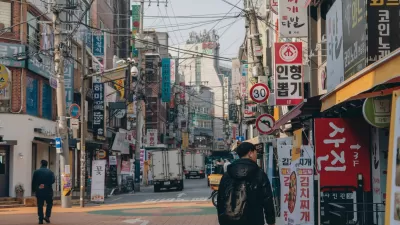A "crazy idea" to remove an inner city freeway in Seoul, South Korea turned to reality. This piece tells the story about how this unlikely event came to be.
Dr. Kee Yeon Hwang led the effort to remove the freeway simply by wondering -- and modeling -- whether traffic would be any worse if the freeway were not there.
"But the model was the easy part. Getting public and political buy-in was going to be harder -- not to mention that people kept telling him this was "suicide" as a transportation planner and that if the project were built it would create "gridlock!" and "traffic chaos!" (Yet another familiar refrain heard in Seattle when mention of the "Transit and Streets" proposal for replacing the Viaduct is made -- not to mention other successful freeway removals in Portland, San Francisco, New York, and Milwaukee).
With a mayoral election coming up, Dr. Hwang and his "crazy" colleagues decided to shop the idea around to the candidates and found one willing to make it part of his central campaign platform: Lee Myung-bak. He ran on tearing down the elevated freeway and restoring the river -- and won. There's an ironic twist to the story at this point that made me happy to sacrifice all those stats in order to hear this fascinating tale: Lee Myung-bak had been the president of the construction company that built the freeway. Who better than he to admit it was a mistake to have been done in the first place?"
FULL STORY: Seoul tears down an urban highway and the city can breathe again

Manufactured Crisis: Losing the Nation’s Largest Source of Unsubsidized Affordable Housing
Manufactured housing communities have long been an affordable housing option for millions of people living in the U.S., but that affordability is disappearing rapidly. How did we get here?

Americans May Be Stuck — But Why?
Americans are moving a lot less than they once did, and that is a problem. While Yoni Applebaum, in his highly-publicized article Stuck, gets the reasons badly wrong, it's still important to ask: why are we moving so much less than before?

Using Old Oil and Gas Wells for Green Energy Storage
Penn State researchers have found that repurposing abandoned oil and gas wells for geothermal-assisted compressed-air energy storage can boost efficiency, reduce environmental risks, and support clean energy and job transitions.

What Forest Service Cuts Mean for Cities
U.S. Forest Service employees work on projects that have impacts far beyond remote, rural wilderness areas.

North Texas Transit Leaders Tout Benefits of TOD for Growing Region
At a summit focused on transit-oriented development, policymakers discussed how North Texas’ expanded light rail system can serve as a tool for economic growth.

Poorest NYC Neighborhoods Pay Price for Delivery Boom
The rise of ‘last-mile’ e-commerce warehouses — and their attendant truck traffic and air pollution — is disproportionately impacting the most historically disadvantaged parts of the city.
Urban Design for Planners 1: Software Tools
This six-course series explores essential urban design concepts using open source software and equips planners with the tools they need to participate fully in the urban design process.
Planning for Universal Design
Learn the tools for implementing Universal Design in planning regulations.
Heyer Gruel & Associates PA
City of Moreno Valley
Institute for Housing and Urban Development Studies (IHS)
City of Grandview
Harvard GSD Executive Education
Salt Lake City
NYU Wagner Graduate School of Public Service
City of Cambridge, Maryland





























